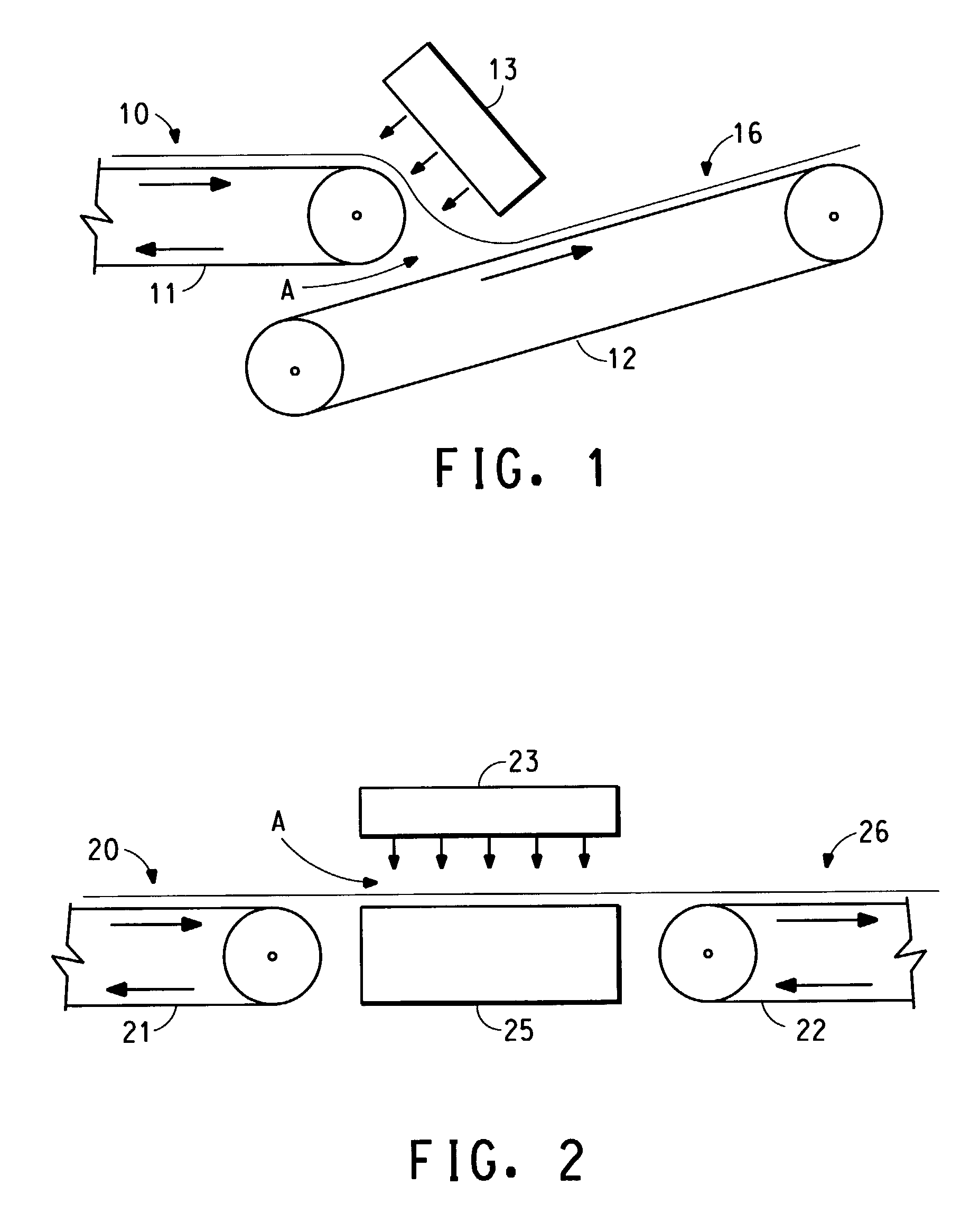Stretchable multiple-component nonwoven fabrics and methods for preparing
- Summary
- Abstract
- Description
- Claims
- Application Information
AI Technical Summary
Problems solved by technology
Method used
Image
Examples
example 1
[0074]Side-by-side, bicomponent filament yarn was prepared by conventional melt spinning of polyethylene terepthalate (2GT) having an intrinsic viscosity of 0.52 dl / g and polytrimethylene terepthalate (3GT) having an inherent viscosity of 1.00 dl / g through round 68 hole spinnerets with a spin block temperature of 255° C.–265° C. The polymer volume ratio in the filaments was controlled to 40 / 60 2GT / 3GT by adjustment of the polymer throughput during melt spinning. The filaments were withdrawn from the spinneret at 450–550 m / min and quenched via conventional cross-flow air. The quenched filament bundle was then drawn to 4.4 times its spun length to form yarn of continuous filaments having a denier per filament of 2.2, which were annealed at 170° C., and wound up at 2100–2400 m / min. For conversion to staple fiber, several wound packages of the yarn were collected into a tow and fed into a conventional staple tow cutter to obtain staple fiber having a cut length of 1.5 inches (3.8 cm) an...
example 2
[0079]The bicomponent filaments of Example 1 were cut to a length of 2.75 inches (7 cm) and blended at a level of 50 weight percent with commercial 2GT polyester staple at 0.9 denier per filament and a length of 1.45 inches (3.7 cm). The polyester was T-90S, available from E. I. du Pont de Nemours and Company, Wilmington, Del. (DuPont).
[0080]The blended fibers were processed through a standard J. D. Hollingsworth Nonwoven Card (J. D. Hollingsworth on Wheels, Greenville, S.C.) to provide a nonwoven web having a basis weight 0.7 oz / yd2 (23.7 g / m2). The blended web, 80 inches (203 cm) wide, was cross-lapped into a 80 inch (203 cm) wide batt weighing approximately 4.0 oz / yd2 (135.6 g / m2) and mechanically needled with 130 penetrations per square inch (20.2 penetrations / cm2) while it was drafted in the machine direction by a ratio of 1.3 / 1. The resulting lightly-needled, cross-lapped web weighed approximately 3.0 oz / yd2 (101.7 g / m2). At this stage, the product was soft, bulky, and cohesiv...
example 3
[0085]The fabric of this example comprised the following blend of fibers:
[0086]50% 2GT / 3GT bicomponent fiber (1.5 inches, 4.4 dpf), 3GT single component fiber (1.5 in (3.8 cm) and 1.6 dpf. The 2GT / 3GT bicomponent was the same as in Example 2. The 3GT fiber was prepared from the same 3GT polymer as was used to make the bicomponent fiber and was prepared on standard staple fiber production equipment.
[0087]This example was performed with the same procedure as Example 2. The fabric had a stretch in both directions (machine and cross) of 30–35% with a 95% recovery (i.e., 5% permanent set). That is, the fabric could be stretched up to 35% and when released it returned to a final state in which it had a 5% increase over the initial unstretched length. It also had excellent drape and softness. The final basis wt. was 5.1 oz / yd2 (172.9 g / m2).
PUM
| Property | Measurement | Unit |
|---|---|---|
| Fraction | aaaaa | aaaaa |
| Fraction | aaaaa | aaaaa |
| Shrinkage | aaaaa | aaaaa |
Abstract
Description
Claims
Application Information
 Login to View More
Login to View More - R&D
- Intellectual Property
- Life Sciences
- Materials
- Tech Scout
- Unparalleled Data Quality
- Higher Quality Content
- 60% Fewer Hallucinations
Browse by: Latest US Patents, China's latest patents, Technical Efficacy Thesaurus, Application Domain, Technology Topic, Popular Technical Reports.
© 2025 PatSnap. All rights reserved.Legal|Privacy policy|Modern Slavery Act Transparency Statement|Sitemap|About US| Contact US: help@patsnap.com



